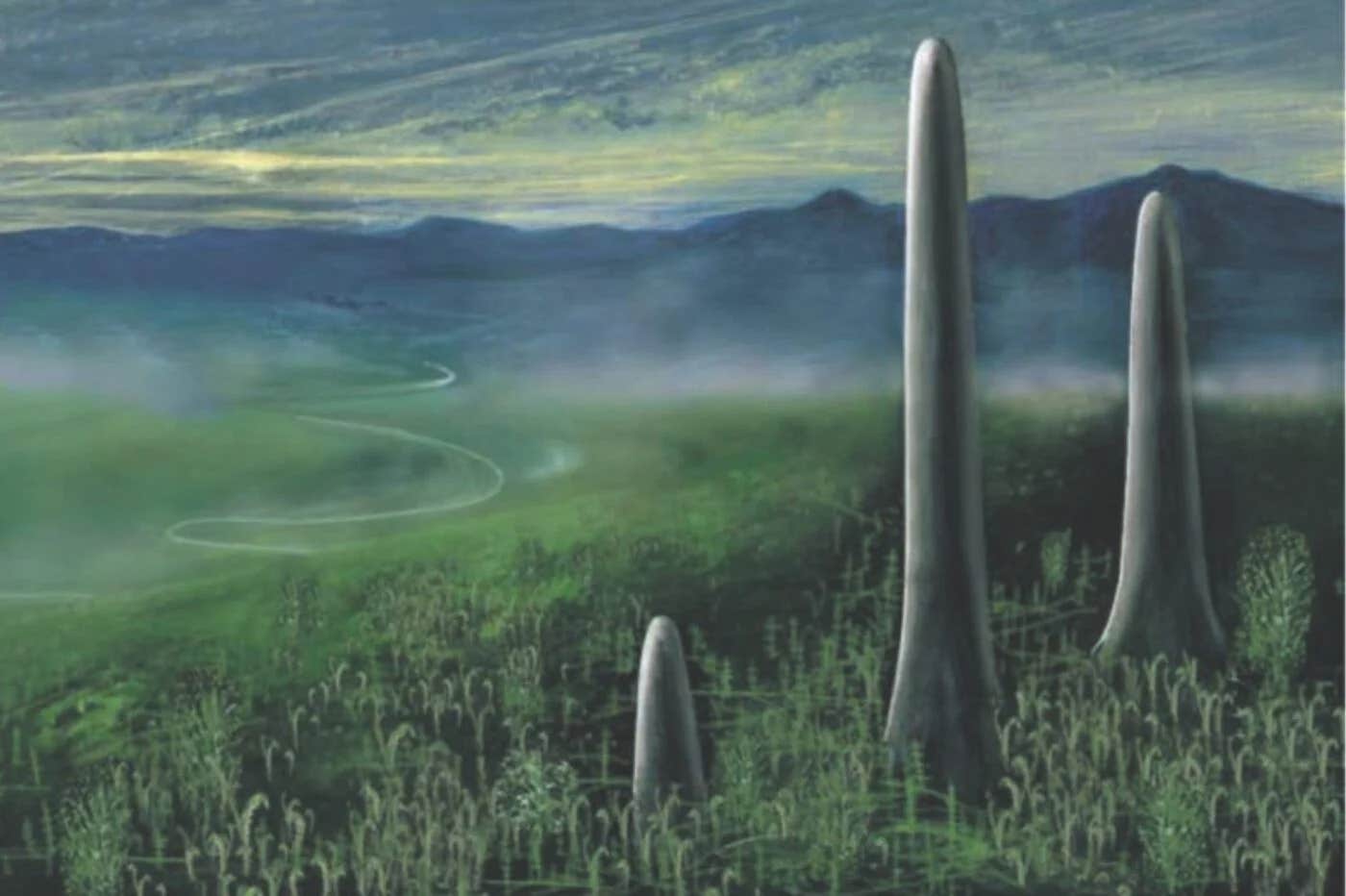Mysterious fossil discovery represents a whole new form of life
A towering organism from Earth’s ancient past may have no living relatives, challenging everything we know about early life on land.

Prototaxites may belong to a now-extinct lineage, defying classification as fungus, plant, or animal. (CREDIT: CC BY-SA 4.0)
In a world that looked nothing like today’s, long before the rise of the dinosaurs or even the first trees, giant living towers stretched skyward from the Earth’s surface. Some reached heights of 26 feet, with trunks nearly 3 feet wide.
These towering life-forms, known as Prototaxites, appeared around 430 million years ago during the Silurian period, dominating a landscape where early plants barely grew past your ankles. But despite their size and strange appearance, scientists have never agreed on what these organisms actually were.
For over 165 years, experts have tried to solve the mystery of Prototaxites. It has been labeled a fungus, an alga, a conifer, or something entirely different. Now, after decades of debate, researchers may have finally settled the question. Or perhaps they’ve raised an even bigger one: Prototaxites might belong to a group of organisms that no longer exists.
First Discoveries, Lingering Doubts
The story began in 1843, when large fossilized trunks were discovered on the shores of Gaspé Bay in Canada. John William Dawson, a geologist, believed he had found the remains of rotting trees. He called the organism Prototaxites, meaning “first conifer.” The name stuck, even though the fossil didn’t quite match any known trees. In fact, trees didn’t even exist during the Silurian period, making that conclusion questionable from the start.
Later discoveries led scientists to reconsider. Paleontologist Francis Hueber reignited the debate in 2001 by proposing that Prototaxites was an enormous fungus. This theory gained traction when a 2007 study examined carbon isotopes in the fossils and found evidence of a heterotrophic lifestyle—one where organisms feed on other organisms—similar to fungi. Popular media jumped on the idea, proclaiming that giant fungi once ruled the Earth.
In 2017, a separate fossil fragment from a smaller species, Prototaxites taiti, appeared to support the fungal theory. This piece was thought to resemble structures found in modern Ascomycota, a group of fungi that includes yeasts and molds. But not all researchers were convinced. Some doubted whether the so-called “fertile” section with spores was even connected to the main body of the fossil.
A Closer Look at Prototaxites taiti
To settle the debate, paleobiologist Corentin Loron and his team at the University of Edinburgh studied three different fragments of P. taiti found in Aberdeenshire, Scotland. Although these fossils were smaller than their towering cousins, they were preserved well enough for detailed examination of both structure and chemistry.
Related Stories
One fragment contained a network of tubes of various sizes and shapes. Some were thin and branched. Others were large and curved but did not branch at all. The largest tubes had thick walls and strange ring-like patterns, unlike anything seen in fungi today.
In known fungi, rings appear only in specialized spore-producing cells called elaters—not in the main body. Another oddity was the presence of dark medullary spots inside the fossil, which do not exist in any extant fungal species.
Then came the chemical analysis. Fungal cell walls contain chitin, a tough substance also found in insect shells. When chitin breaks down during fossilization, it leaves behind sugars like glucosamine.
But in P. taiti, none of these chitin-related sugars were found. Instead, the cell walls contained aliphatic, aromatic, and phenolic compounds—chemical fingerprints more similar to lignin, which is found in plants. Yet the structure of the organism clearly didn’t match any known plant.
The research team ruled out other possibilities too. Could it be algae? Not with that complex internal structure. What about a lichen—a partnership of algae and fungi? The anatomy didn’t fit. Maybe an ancient animal? No animal has ever had cell walls like these.
"We found no support for the most widely held view that Prototaxites was fungal," the researchers said. "No extant group was found to exhibit all the defining features of Prototaxites."
A Life Form Without Descendants
The team concluded that Prototaxites cannot be placed in any known group of life—fungi, plant, animal, or algae. They believe it came from an entirely extinct lineage of eukaryotes, a broad category that includes all complex cells with nuclei. If they’re right, this changes our understanding of early life on land.
The Rhynie chert, a fossil-rich deposit in Scotland where P. taiti was found, offers a unique window into ancient ecosystems. It preserves a snapshot of early land life from 407 million years ago, including microbes, fungi, and early plants. Comparing P. taiti to other fossils from the same deposit allowed researchers to test their findings with extra precision. Every other known fungal fossil from Rhynie showed chemical signs of chitin. P. taiti didn’t.
Until now, P. taiti was sometimes thought to be a “basal member” of the Ascomycota fungi group. But this assumption rested on the idea that a supposed spore sac was part of the same organism. Loron’s team disagrees. They found no physical or organic connection between the spore-like structures and the main vegetative body. They argue that without such a connection, the parts should be considered separately.
This changes how scientists interpret the ecology of Prototaxites. If it wasn’t a fungus, how did it live? Did it photosynthesize? Did it absorb nutrients from the soil? These questions remain unanswered, but they highlight the strangeness of this long-lost form of life.
The Mystery of Evolutionary Dead Ends
Sometimes, life creates experiments that never take off. Evolution isn’t a straight line. It’s a branching tree with many dead ends. Most life forms that ever existed are now extinct, leaving behind no descendants. Prototaxites may be one of those evolutionary experiments—a form of life that thrived for millions of years, then vanished, leaving only fossils and unanswered questions.
What caused its extinction remains unclear. It might have been outcompeted by other land organisms as ecosystems evolved. Or perhaps it relied on environmental conditions that changed too quickly. Whatever the cause, no other known organism shares its unique mix of features.
That doesn’t mean it’s any less important. In fact, its uniqueness helps researchers better understand the limits of biology and the possibilities of ancient life. Prototaxites is a reminder that Earth’s history is full of wonders we still don’t fully understand.
Loron and his team’s findings are currently available on the preprint server bioRxiv and await peer review. If confirmed, the results could finally close the chapter on more than a century of scientific debate. Or perhaps they’ll open the door to even more mysteries about life’s early history.
Note: The article above provided above by The Brighter Side of News.
Like these kind of feel good stories? Get The Brighter Side of News' newsletter.
Rebecca Shavit
Science & Technology Journalist | Innovation Storyteller
Based in Los Angeles, Rebecca Shavit is a dedicated science and technology journalist who writes for The Brighter Side of News, an online publication committed to highlighting positive and transformative stories from around the world. With a passion for uncovering groundbreaking discoveries and innovations, she brings to light the scientific advancements shaping a better future. Her reporting spans a wide range of topics, from cutting-edge medical breakthroughs and artificial intelligence to green technology and space exploration. With a keen ability to translate complex concepts into engaging and accessible stories, she makes science and innovation relatable to a broad audience.



